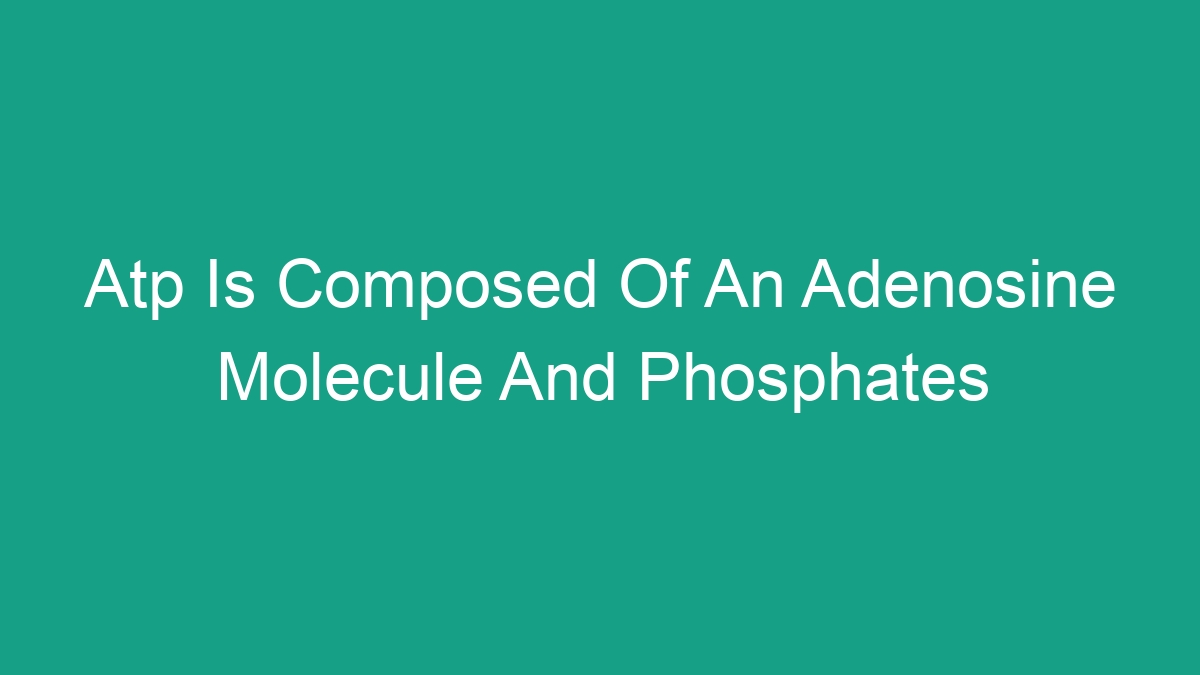
ATP, or adenosine triphosphate, is a vital molecule that serves as the primary energy currency of the cell. It is often referred to as the “energy currency” of the cell due to its role in providing energy for various cellular processes. In this article, we will dive into the composition of ATP, its role in cellular metabolism, and the significance of this molecule in sustaining life.
Composition of ATP
ATP is composed of an adenosine molecule and three phosphate groups. The adenosine molecule consists of an adenine base and a ribose sugar, while the phosphate groups are composed of phosphorus and oxygen atoms.
Adenosine Molecule
The adenosine molecule in ATP consists of an adenine base, which is a nitrogen-containing compound, and a ribose sugar. The adenine base is a purine derivative, and it is essential for the structure and function of ATP. The ribose sugar, a 5-carbon sugar, forms the backbone of the adenosine molecule.
Phosphate Groups
The three phosphate groups in ATP are essential for its role as a high-energy molecule. These phosphate groups are linked together by high-energy bonds, which store a significant amount of energy. When these bonds are hydrolyzed, energy is released, providing fuel for cellular processes.
Role of ATP in Cellular Metabolism
The primary role of ATP in cellular metabolism is to provide energy for various cellular processes. ATP is involved in processes such as cellular respiration, photosynthesis, muscle contraction, and active transport across cell membranes. It serves as a universal energy carrier, facilitating the transfer of energy within the cell.
ATP Synthesis
ATP is synthesized through processes such as cellular respiration and photosynthesis. In cellular respiration, ATP is produced through the process of oxidative phosphorylation, where energy from the oxidation of glucose is used to phosphorylate adenosine diphosphate (ADP) to form ATP. In photosynthesis, ATP is generated during the light-dependent reactions, where light energy is used to produce ATP from adenosine diphosphate and inorganic phosphate.
ATP Hydrolysis
When energy is required for cellular processes, ATP undergoes hydrolysis, a process where a water molecule is used to break the high-energy phosphate bond, releasing energy. This energy is used to drive various cellular processes, such as muscle contraction, active transport of molecules across cell membranes, and synthesis of macromolecules.
Significance of ATP in Sustaining Life
The significance of ATP in sustaining life cannot be overstated. Without ATP, essential cellular processes would not have the energy required to function. ATP provides the energy necessary for growth, repair, and maintenance of cells, tissues, and organs. It is involved in processes such as DNA replication, protein synthesis, and nerve impulse transmission. Additionally, ATP plays a crucial role in maintaining the electrochemical gradient across cell membranes, which is essential for cellular homeostasis.
ATP and Muscle Contraction
During muscle contraction, ATP is hydrolyzed to provide the energy required for the sliding of actin and myosin filaments, which generates force. This process is essential for movement and physical activity. Without ATP, muscle contraction would not be possible, and essential bodily functions such as locomotion, breathing, and digestion would be impaired.
ATP and Active Transport
ATP is also involved in active transport across cell membranes, where it provides the energy necessary to move molecules and ions against their concentration gradients. This process is crucial for the uptake of nutrients, elimination of waste products, and maintenance of ion balance within cells. Without ATP, cells would not be able to maintain their internal environment, leading to cellular dysfunction and ultimately, cell death.
Conclusion
ATP is a critical molecule in cellular metabolism, providing the energy required for various biological processes. Its composition, consisting of an adenosine molecule and three phosphate groups, allows it to function as a high-energy molecule. Without ATP, essential cellular processes such as muscle contraction, active transport, and DNA replication would not be possible. Understanding the role of ATP in sustaining life is essential for gaining insight into the fundamental processes that drive living organisms.
References:
- Alberts, B., Johnson, A., Lewis, J., Raff, M., Roberts, K., & Walter, P. (2002). Molecular Biology of the Cell. New York: Garland Science.
- Berg, J. M., Tymoczko, J. L., & Gatto, G. J. (2015). Biochemistry. New York: W. H. Freeman.
- Lehninger, A. L., Nelson, D. L., & Cox, M. M. (2000). Principles of Biochemistry. New York: W. H. Freeman.




